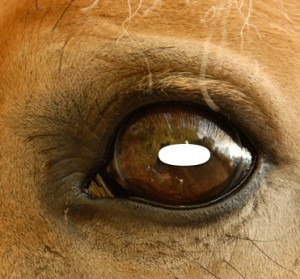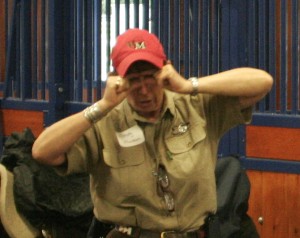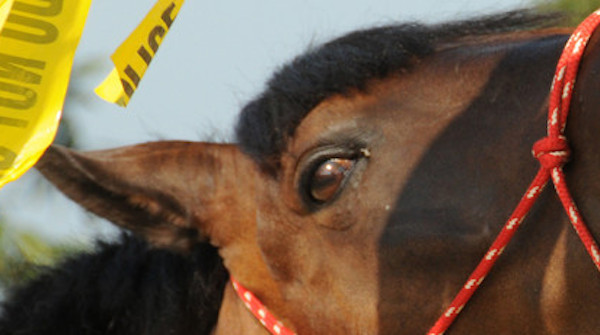
Does your horse shy at stationary objects? Do you feel like he is trying to avoid work? Does he react to the same object again and again no matter how hard you try to make him face it? Understanding how your horse sees can help you come up with a better strategy for solving shying problems.
Next time you ride, notice how your horse carries his head. Is it up in the air, off to one side or looking out on the circle? If he is a frequent shyer, notice how you react to the situation. Do you hold your breath, tighten your legs or pull on his head? Does he drop his head and then jump to the side, especially when you kick him to go forward? If you force him to face the object, does he get worse instead of better? Perhaps if you experience what it is like to see the way your horse does you will be more understanding next time he starts to shy.
The horse’s eyes, contrary to popular myth, have more cross hemisphere connections in the brain than yours have. In other words, horses transfer information from each eye to the opposite side of their brain quite easily*. You still have to train your horse from both sides but this is not because the information hasn’t transferred. Horses also have a great visual ability to detect motion.

Unlike your eyes with round pupils, the horse’s pupils are horizontal. See Photo 1. This shape makes his eyes excellent for seeing things far way on the horizon but not very good for seeing things down by his feet. Therefore when you are riding into a corner where there is something on the ground, he cannot see it very well. In order to get a better look, he must line his horizontal pupil up with the object. This causes him to lower and tilt his head to one side. If you punish him at that moment, he will associate the pain with the object, as if the object was the cause of the pain! He will be more concerned the next time because the thing he couldn’t see has bitten him!
To experience what it is like to have horizontal pupils take your thumb and index fingers of both hands and form a slit. See Photo 2. Place the slit in front of your eyes and walk around. Or take a pair of plain glasses and make a horizontal pupil using some tape to block off the top and bottom of the lens. See Photo 3. Put the glasses on and walk around, paying special attention to what you have to do with your head to see objects down by your feet. You will have to tilt your head just like your horse! Walk with your head in the air and you will realize the horse can’t see anything but sky! Walk with your chin tucked to your chest and you can only see a small portion of ground directly below you.

Now that you have a better understanding of what your horse experiences, you can appreciate why he would shy. To help him overcome his fear, stop far enough away from the object to allow him to lower his head to see it clearly. Check that you are breathing. Wait there until he licks and chews, then walk away. Repeat this step many times until you can approach the object from the side (horse parallel to the object) not head on! Stand near it until he totally relaxes (perhaps 10 minutes if he is really concerned). You may find that he wants to walk up to the object and put his nose on it. You have to be careful he doesn’t give himself a fright at this moment! However, when he becomes curious instead of fearful, you are getting there! Waiting also gives you time to relax and send the message to him that you are not concerned. Horses are very sensitive to changes in your breathing and tension and take that as a message to prepare to flee. When you send calming signals, they can relax as well.
Use this Murdoch Minute to experience what it is like to have horse eyes. When you understand how difficult it is to see things by your feet, you can appreciate why your horse might shy. Give your horse time to evaluate the object from a safe distance where you can both breath, and gradually work toward it until he is able to lick and chew (signs of positive learning). And always remember to enjoy the ride!
* Hanggi, E. B. 1999. Interocular transfer in horses (Equus caballus). Journal of Equine Veterinary Science, 19(8), 518-524.




